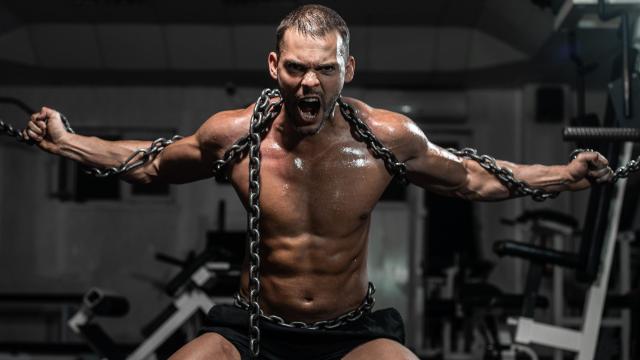There are very few things that look cooler on Instagram than doing a heavy lift with massive chains hanging off your barbell. But those chains aren’t just for looks (if you’re using them right, that is.) Here’s what you need to know about using chains in the gym.
They make the top of the movement heavier
The classic use of chains in the gym is for Westside-style accommodating resistance. The idea here is to use chains that are long enough that they reach the floor when you’re at the top of the movement. Then, as you lower down into your squat or your bench press, the links of chain begin to pile on the floor.
At the bottom of the movement, your body is only really holding the weight of the bar and plates, and very little of the weight of the chain. As you stand up in your squat (to use one example), you take on more and more of the weight. Here’s an example showing what this looks like:
This style of training — with chains or with other equipment like bands — made a lot of sense in the golden age of equipped powerlifting. A special suit makes the bottom of the squat a bit easier, since it supports your body more in that position. That’s helpful because the bottom is the hardest part of the movement. But as you stand up from your squat, you need to support more of the weight of the barbell without help. Lifting with chains can mimic that “resistance curve.”
But even lifters who don’t compete in specialty squat suits or bench shirts often like to train with chains or bands. To be clear, lifts with chains shouldn’t replace your regular lifts; they’re an option you can add in for variety.
So should you start loading up chains onto some of your lifts? If you’d like to play around, sure. But if you want to get the most out of them, read up on the details of when to use them and how to know how much weight to add. Here’s one guide from T-nation, although the best way to learn is by talking to coaches or experienced lifters. There’s a bit of an art to finding the right setup.
Strength coach Alex Bromley writes in his book Peak Strength that squats with chains are “one of those movements that can provide a big return IF they are applied correctly (and that’s a big ‘if’). The complexity of setting them up and finding appropriate ratios of straight-weight to band [or chain] tension make them less appropriate for inexperienced lifters.” He gives an even stronger version of this caveat when giving advice about bench press, concluding: “Generally, those trying to fix their poverty bench have imbalances in their physique that need to be addressed, need more [muscle] mass and need a more consistent technical setup. All of these should be addressed before spending 20 minutes finding the right band [or chain] to weight ratio.”
Other ways of using chains
Besides loading chains onto a barbell, you can also use their advantages for other strength training movements. Here’s Brie Larson (whose trainer we interviewed, by the way, if you want more of her strength secrets), using them for pushups:
Notice that many of the chain links are on the floor at the bottom of the movement, and nearly all off the ground at the top. Just as with barbell lifts, if you want to set up chains for other exercises, you’ll need to play around with the length and positioning to make sure you’re using them correctly.
Chains are also handy for other purposes, so if you have them in your gym, don’t be afraid to get creative. Here’s an old photo from Westside showing how they used chains and a plate to make a sled that probably sounded absolutely horrendous when you dragged it:
I don’t use chains for accommodating resistance in my home gym, but I do have a few short lengths of chain that are handy in a few other scenarios. I even made a sled for dragging (before I saw the above post) by wrapping a chain around an old tire, and then attaching a tow strap to the chain. That let me load weights onto the tire and drag it around without worrying about fraying the tow strap.
I also use small chains to add weight to awkward objects, like here where I’ve chained some extra weight plates to a large kettlebell. You can also hang chains over your neck for bodyweight exercises like dips or pullups. Think of them as acting like a weighted vest, only they look much cooler.

Leave a Reply
You must be logged in to post a comment.